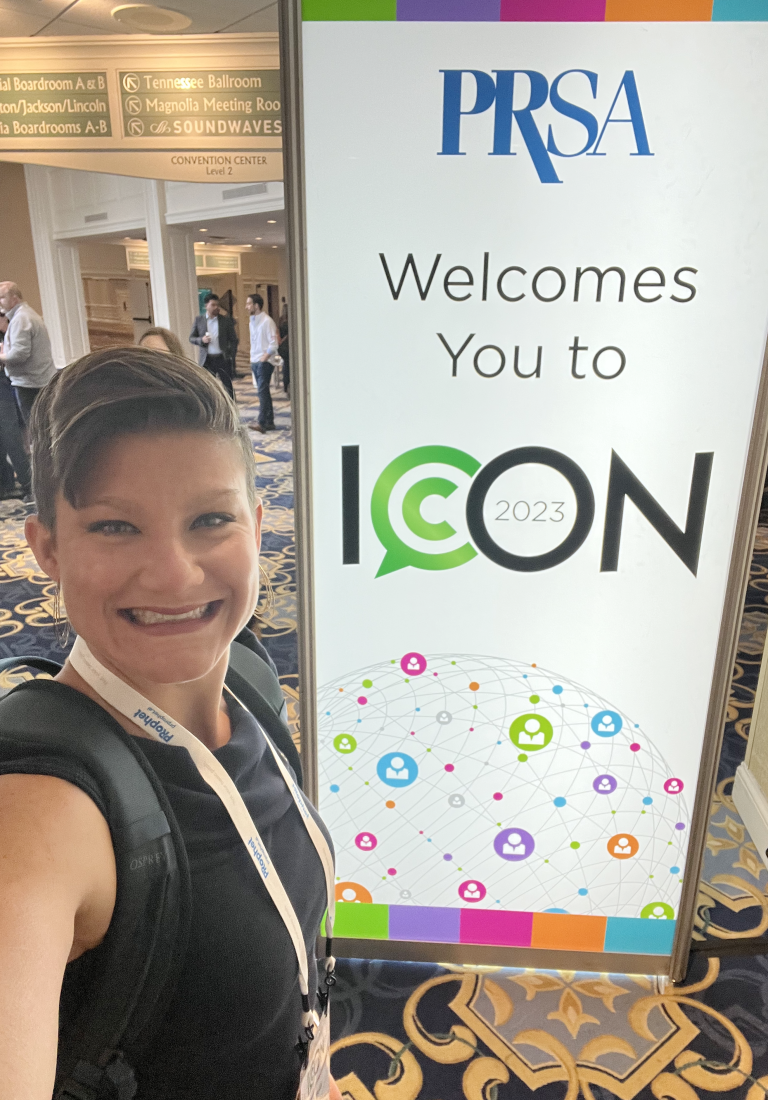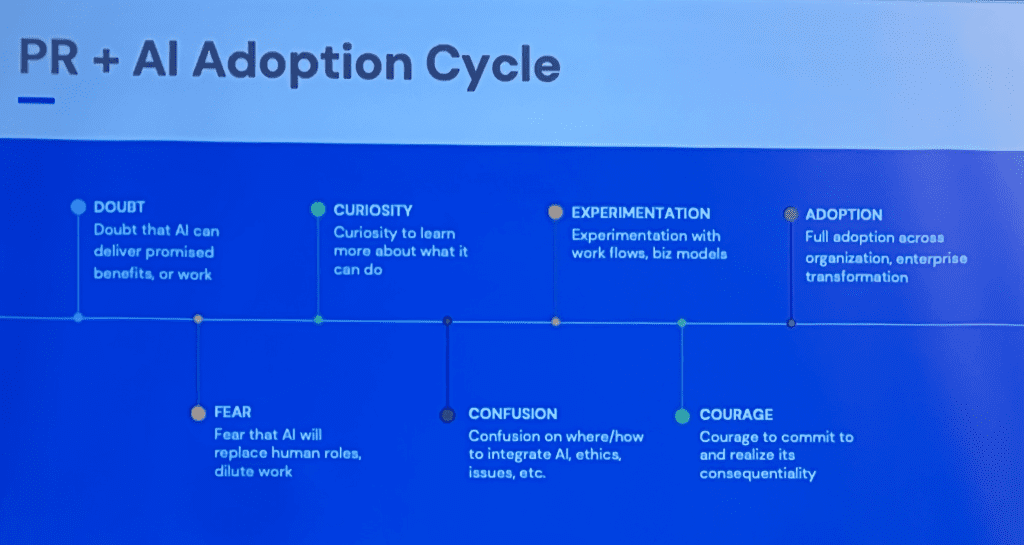I used to consider myself an early adopter. After all, as a college freshman in ‘06, I was one of the first with a Facebook profile (back in the good old days when you needed an .edu email address to create one).

Turns out I’ve been a little closed-minded about AI, and was forced to realize that fact at the ICON 2023 Public Relations Society of America (PRSA) International Conference in Nashville last month.
I thought AI was a cool and useful tool, just not for me. I had viewed AI as a bit of an insult to the education and practice I’d dedicated to growing my expertise as a public relations and communications practitioner. I had some reservations. According to the National School Public Relations Association’s (NSPRA) recent flash survey of its membership, I wasn’t alone.
Of the 500+ school communications professionals who participated in NSPRA’s survey, 10 percent feared that using AI was unethical, and 26 percent reported they were concerned that AI would make their writing sound formulaic.
According to PRSA presenter Aaron Kwittken’s “PR + AI Adoption Cycle,” I was hanging out between the “Fear” and “Confusion” stages: a little fearful about AI diluting my work and confusion about how to implement it ethically.
The founder of global PR agency KWT Global, Kwitten created PRophet, a generative and predictive AI-driven platform specifically designed with public relations practitioners in mind. Along the way, he’s pinpointed the stages of adoption among public relations professionals: Doubt – Fear – Curiosity – Confusion – Experimentation – Courage – Adoption.
Kwittken noted a common pushback from communicators in the Doubt phase is, “We’re not in the business of automation, we’re in the business of articulation.” Oof, that hit home.
But I was wrong. AI isn’t coming for my job, or for my role because I can’t do my job. Because for AI to work, it needs the human element in the loop.
Both Kwittken and Ivan Pollard, the Leader of the Marketing & Communications Center at The Conference Board, emphasized in their ICON sessions that the human element is where our expertise still lies.
Only now these “communications engineers” who choose to adapt have a tool that can help optimize our tactics, ultimately freeing us up for more creativity.
“We have had an art in our industry for decades,” said Kwittken. “Now, we have a science.”

Pollard compared using generative AI to running a race – a metaphor that definitely resonated with me. Using AI to prompt and then draft versus laboring over outlines and first drafts of content is like having a relay partner tackle the first part of a race, leaving us to complete the rest. “It’s still a human decision of what ‘beautifully told’ looks like,” he said.
And since everyone has access to the same AI tools and the data they source, we’re all running the same race – until we pull away from the pack using our unique abilities. “Everyone is together on the first lap,” Pollard said. “How we differentiate is down to us.”
By using AI, Pollard explained, communications engineers can “automate the doing and liberate the thinking,” or make their workflow more predictive, leaving them with more bandwidth and time for the advisory function. And that strategic role is ideally how a communicator’s value (in K-12 and all sectors) should be measured, not by just their tactical output.
My takeaways on the ethics of using AI come down to intent and transparency. Just like other “study tools” (any other Millenials thinking SparkNotes?) AI should be viewed as an idea generator or research assistant, not the author.
Justin Seibert, founder and president of Direct Online Marketing – a top 3% globally Premier Google Partner – offered tips for using the resource responsibly. After using AI to generate new ideas to save time in the drafting process, Seibert recommends guarding against plagiarism by running the final product through an AI checker and ensuring it shows a high percentage of unique content.
Seibert and Pollard agreed a best practice is citing one’s use of AI, by simply adding a disclaimer at the bottom of blog posts, presentations, and other content noting that the tool was used in the outlining or drafting of the final product. That’s a takeaway I immediately plan to start implementing.
And I plan on doing more in the Experimentation and Courage stages of the “PR + AI Adoption Cycle,” by learning more about predictive and prescriptive AI versus generative AI, testing it out in my own workflows, and bringing AI experts onto the “Productive Disruption” podcast to discuss its use and impact for K-12.
Because if we’re going to run this race together, we’ve got to adapt. And I’m not a fan of getting lapped.
Sources:
Hunter, N. (2023, October 17). Nearly Half of NSPRA Members Use AI Tools Daily or Weekly. NSPRA.
Kwittken, A. (2023, October). Adapt Or Get Lapped: How to Be a Communications Engineer. ICON 2023 – PRSA International Conference. Nashville, Tenn.
Pollard, I. (2023, October). Automate the Doing, Liberate the Thinking. ICON 2023 – PRSA International Conference. Nashville, Tenn.
Seibert, J. (2023, October). SEO & PR at the Altar: Say I Do to Google to Grow Your Effectiveness. ICON 2023 – PRSA International Conference. Nashville, Tenn.
Molly is the liaison between education leaders and the agency, connecting the K-12 community with services designed to accelerate performance and market position. She leads content and partner engagement strategy and is a frequent conference presenter and podcast/blog guest. Molly likes to push it to the limit, and races competitively in Obstacle Course Races on the weekends.
-
Molly McGowan Gorsuch, APRhttps://www.rhodesbranding.com/author/molly/
-
Molly McGowan Gorsuch, APRhttps://www.rhodesbranding.com/author/molly/
-
Molly McGowan Gorsuch, APRhttps://www.rhodesbranding.com/author/molly/
-
Molly McGowan Gorsuch, APRhttps://www.rhodesbranding.com/author/molly/



